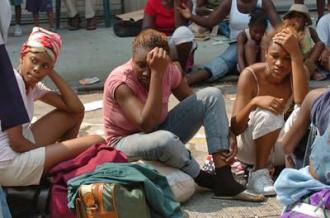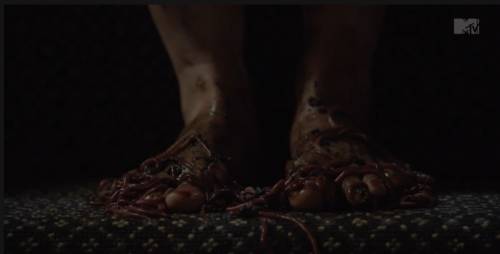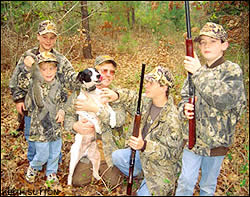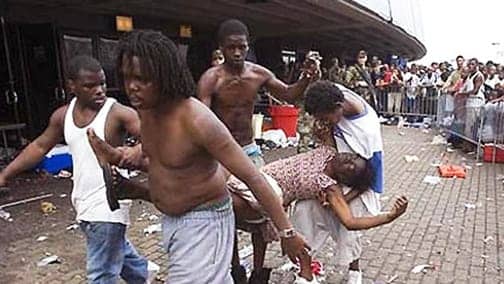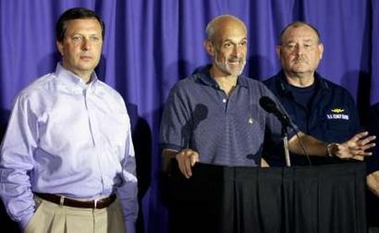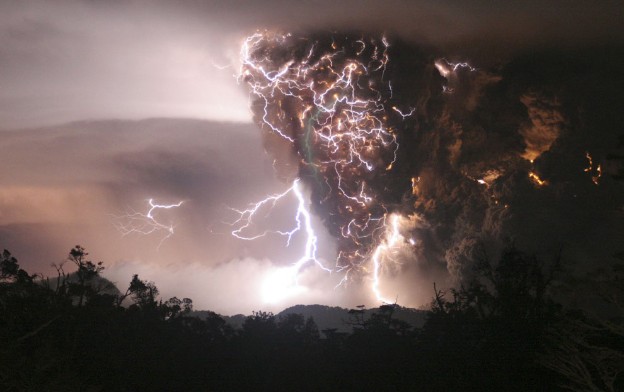This is the eighth installment on this topic.
To read from the beginning please go to entries beginning 9/20/12.
Parallel to The Chef, approximately one mile to the north is I-10 and equally as far north of that is Hayne Boulevard running along the Pontchartrain lakefront . These east-west thoroughfares are tied together by 4-6 primary roadways running roughly north and south. Since those are approximately equidistant from each other between our starting point and the I-610 connection to St. Bernard Parish on the far east end near the NASA plant, these roads would be our staging areas.
 Each of them was situated closely enough to the high water that the elevation of Hwy 90 provided nearly perfect boat launches into the flooding. Our group's vessels were dispersed at four of these launch locations. Ours in particular set up operations at
Each of them was situated closely enough to the high water that the elevation of Hwy 90 provided nearly perfect boat launches into the flooding. Our group's vessels were dispersed at four of these launch locations. Ours in particular set up operations at Read
Blvd.
Because we could launch only one rig at at time, many were afloat and gone before anyone appeared with instructions or guidance. Impatiently and hurriedly, they sped off, hopefully to return with people and information. All boats could steer only north initially. We assumed there would be some organization to their action once they began hitting the cross streets of the neighborhoods where they might fan out for full coverage of the area. The water in the roadways provided ample clearance for the propellers almost immediately after entry. After each boat had barely left the "dock", their motors were opened full throttle, sending wakes into the small front yards and walls of the closely-spaced homes.
Once the last boat had set off, it seemed the others began returning almost immediately, loaded with weary faces. Some appeared relieved, some concerned. Some had minor injuries and some had different levels of disabilities. Some were reluctant to show relief just yet, as they seemed to know this was only one short leg of a much longer ordeal that had begun with the clouds moving in before the wind and water. Where, when or how it would end remained to be seen.
Our guys were gone again as soon as unloading was complete.

It did not seem that we had just begun preparing for this journey only about 24 hours before. We were in a new place and a different time. It had taken ages, it seemed, to get there. We had hit brick walls and had stopped and started so many times that no one was concerned with details or plans when the crews finally got into the water and began shoving off. Not much was discussed about what would happen next.
The arriving passengers were impatient as well, to have their chance to step out of each small dinghy and to walk on dry ground. Their exits were prompt. Except for a few errant slips, all who could disembark themselves did so quickly and without incident. Those who were sick, infirm, elderly or otherwise impaired would be helped or lifted carefully and gently by the biggest and burliest of our guys. Upon exiting, many engaged in idle chatter and some exchanged greetings and smiles. Each would have stories of the last few days and would begin sharing them with each other.
During the cooling breeze of the boat ride and the excitement of the rescue, most seemed to not yet notice the rapidly elevating temperature that was now approaching 90 degrees. It was barely mid-morning. Losing their sea legs, they began to survey the scene. Some curious, some bewildered, none could find any immediate indication or guidance as to what would happen next. Like gathering at a corner stop for a city bus with no impending arrival time, the not-yet-fully-rescued strangers drifted up to the shoulder of the highway. No shade, no water. Optional seating was provided by only the hot asphalt shoulder or the grassy sloping ground adjacent to The Chef.
Having spent over two days without electricity, running water or air-conditioning in the sweltering New Orleans heat, it is likely that some hoped for, if not expected, air-conditioned buses and bottled water to greet them. After all, they were being rescued, weren't they? Maybe later.
With one of the first groups brought in, was a slender lady, past middle age but with straight blonde hair styled like a much younger woman. She was happy to be on dry ground but obviously distraught. Unlike others, she did not seem so excited about being safe or out of whatever situation she had left. She told her personal tale of having weathered the storm with her sister. From her tone, it was clear it was not just any sister, if there can be such a thing. This was her lifelong friend, confidante and soul mate. I would guess they were inseparable and could have wished for no better companions than each other for fighting a hurricane. At least they were in their home, with each other. As the story unfolded, it became clear that she had not only lost track of her sister, but she had lost her completely. As she sobbed uncontrollably, she told us that her sister had been dragged from her very grasp by raging wind and waters and that she had no doubt died.
 Happy that our charge had escaped the torrent and that she was now safe, those who could hear her slowed or stopped their frenetic motion to listen and to share her loss. It was again one of those moments in which the insulation of distance and relationship that shielded us from emotion had crumbled, exposing each of us to this real, very personal circumstance. In these fleeting moments, that we would experience repeatedly during the next few days, our dispassionate rescue job was altered and snapped into a sudden surge of emotion and human connection. Those who heard her were happy she was now safe and heartbroken for her
loss.
Happy that our charge had escaped the torrent and that she was now safe, those who could hear her slowed or stopped their frenetic motion to listen and to share her loss. It was again one of those moments in which the insulation of distance and relationship that shielded us from emotion had crumbled, exposing each of us to this real, very personal circumstance. In these fleeting moments, that we would experience repeatedly during the next few days, our dispassionate rescue job was altered and snapped into a sudden surge of emotion and human connection. Those who heard her were happy she was now safe and heartbroken for her
loss.
The lady regained her composure and disappeared into the crowd to melt in the sweltering sun at the corner and to await the next chapter of her fate with a heavy heart. As the scores, and then hundreds of bedraggled were deposited onto the concrete bank of the new lakefront, they joined the crowd with the others, clueless about what lay before them. Within the hour of the grief-stricken sister arriving, a joyous scream rose up from the crowd in which she had become invisible. Everyone within the sound of her jubilation celebrated in some fashion, the arrival and heartfelt embrace of the first sister with the second who was very much alive.

As the folks passed us to grow into the masses on the corner we were able to piece together their stories and form some idea of the circumstances and conditions they had left, and that we would face going in. Our travelers were coming from rooftops and from attics of homes soaked and consumed by 6-8 feet of water by this third day. Their stories confirmed what we had gathered in bits and pieces from authorities. The water in the mile from The Chef to I-10 progressed from inches to over 6 feet. Beyond that its depth increased to as much as 12 feet approaching the lakefront.
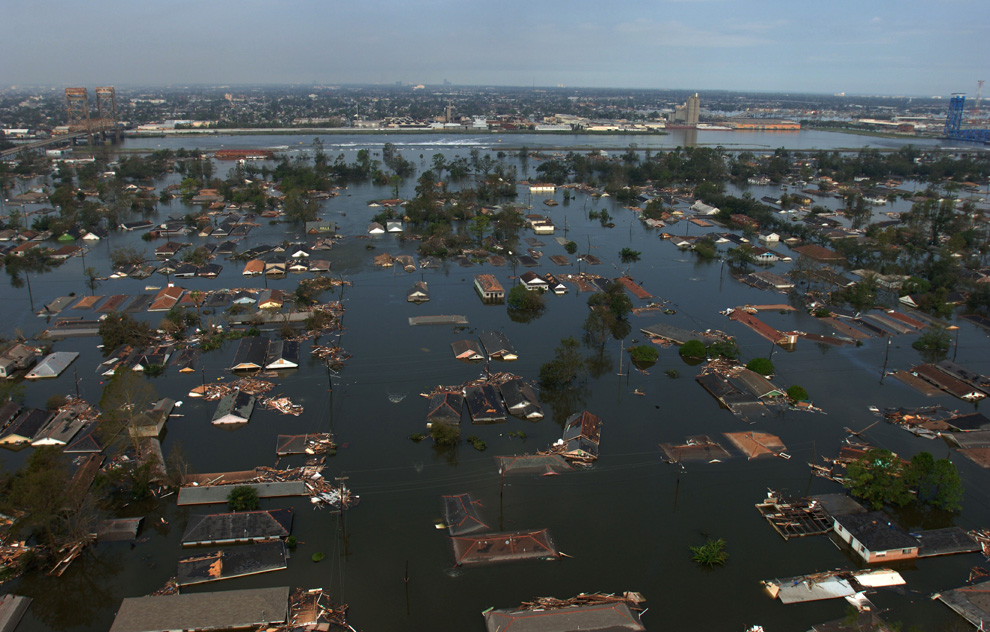
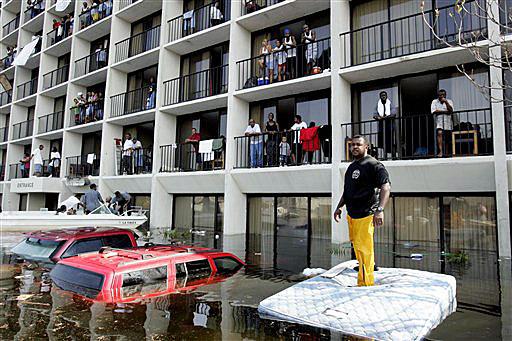


Because we could launch only one rig at at time, many were afloat and gone before anyone appeared with instructions or guidance. Impatiently and hurriedly, they sped off, hopefully to return with people and information. All boats could steer only north initially. We assumed there would be some organization to their action once they began hitting the cross streets of the neighborhoods where they might fan out for full coverage of the area. The water in the roadways provided ample clearance for the propellers almost immediately after entry. After each boat had barely left the "dock", their motors were opened full throttle, sending wakes into the small front yards and walls of the closely-spaced homes.
Once the last boat had set off, it seemed the others began returning almost immediately, loaded with weary faces. Some appeared relieved, some concerned. Some had minor injuries and some had different levels of disabilities. Some were reluctant to show relief just yet, as they seemed to know this was only one short leg of a much longer ordeal that had begun with the clouds moving in before the wind and water. Where, when or how it would end remained to be seen.
Our guys were gone again as soon as unloading was complete.

It did not seem that we had just begun preparing for this journey only about 24 hours before. We were in a new place and a different time. It had taken ages, it seemed, to get there. We had hit brick walls and had stopped and started so many times that no one was concerned with details or plans when the crews finally got into the water and began shoving off. Not much was discussed about what would happen next.
The arriving passengers were impatient as well, to have their chance to step out of each small dinghy and to walk on dry ground. Their exits were prompt. Except for a few errant slips, all who could disembark themselves did so quickly and without incident. Those who were sick, infirm, elderly or otherwise impaired would be helped or lifted carefully and gently by the biggest and burliest of our guys. Upon exiting, many engaged in idle chatter and some exchanged greetings and smiles. Each would have stories of the last few days and would begin sharing them with each other.
Having spent over two days without electricity, running water or air-conditioning in the sweltering New Orleans heat, it is likely that some hoped for, if not expected, air-conditioned buses and bottled water to greet them. After all, they were being rescued, weren't they? Maybe later.
With one of the first groups brought in, was a slender lady, past middle age but with straight blonde hair styled like a much younger woman. She was happy to be on dry ground but obviously distraught. Unlike others, she did not seem so excited about being safe or out of whatever situation she had left. She told her personal tale of having weathered the storm with her sister. From her tone, it was clear it was not just any sister, if there can be such a thing. This was her lifelong friend, confidante and soul mate. I would guess they were inseparable and could have wished for no better companions than each other for fighting a hurricane. At least they were in their home, with each other. As the story unfolded, it became clear that she had not only lost track of her sister, but she had lost her completely. As she sobbed uncontrollably, she told us that her sister had been dragged from her very grasp by raging wind and waters and that she had no doubt died.

The lady regained her composure and disappeared into the crowd to melt in the sweltering sun at the corner and to await the next chapter of her fate with a heavy heart. As the scores, and then hundreds of bedraggled were deposited onto the concrete bank of the new lakefront, they joined the crowd with the others, clueless about what lay before them. Within the hour of the grief-stricken sister arriving, a joyous scream rose up from the crowd in which she had become invisible. Everyone within the sound of her jubilation celebrated in some fashion, the arrival and heartfelt embrace of the first sister with the second who was very much alive.

As the folks passed us to grow into the masses on the corner we were able to piece together their stories and form some idea of the circumstances and conditions they had left, and that we would face going in. Our travelers were coming from rooftops and from attics of homes soaked and consumed by 6-8 feet of water by this third day. Their stories confirmed what we had gathered in bits and pieces from authorities. The water in the mile from The Chef to I-10 progressed from inches to over 6 feet. Beyond that its depth increased to as much as 12 feet approaching the lakefront.



At first, we heard only stories from the Metropolitan Hospital. The information that trickled down to us indicated that it was in fact a hospice. It held patients on their final
journey in this world, who had opted to forego medical treatment and
life-sustaining care. The word from that
building was that a preacher or a priest remained, and that he refused to leave
these dying patients. He had food and
water and the number in his care was not clear. He asked for nothing and would accept nothing, wanting us to use our resources for others. He offered
us gasoline if we needed it. Unless he was running generators, he
certainly would not need it. Every car in the parking lot was completely
submerged by flood waters. Because it seemed to be a situation under control, we bypassed the hospice for the rest of the day, tending to others more in need of our services.
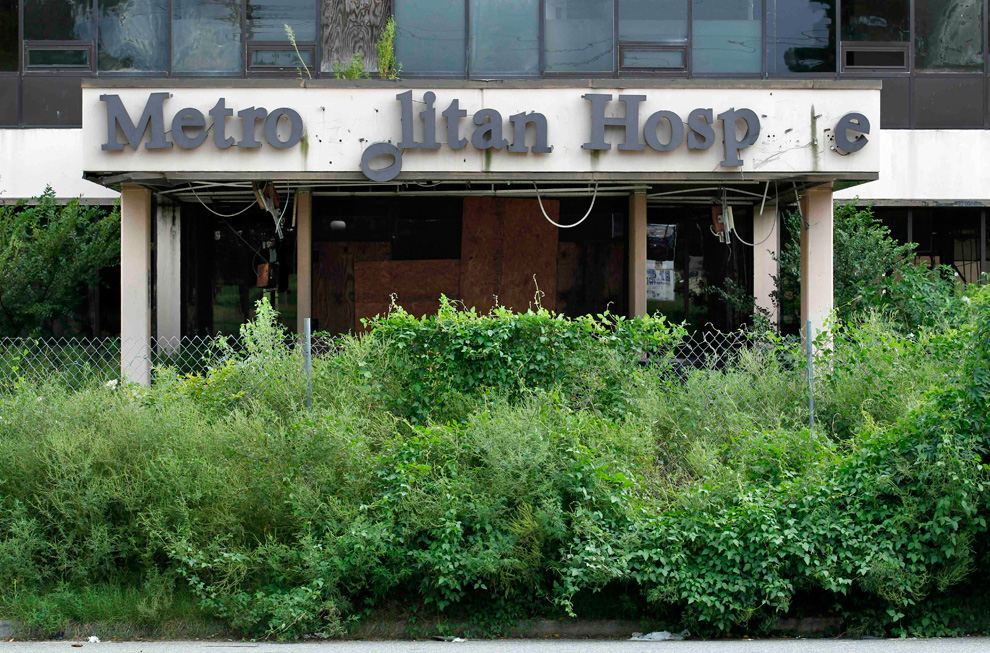 |
| 5 years post Katrina (AP/Boston Globe) |
The acknowledged organizer, director and
head honcho of our group was Ronny Lovett ,
the owner of R & R Construction. That company employed most of our rescuers. However, by her nature, to which Ronny fully and voluntarily deferred at times, the de facto managing director, drill sergeant and
organizer extraordinaire was Sara.
Sara had been instrumental in putting Ronny in business 10 years earlier. She was the company's CPA and was Ronny's long-time friend and adviser. Small in stature, her position on anything was always crystal clear and her decisions always certain. Regardless of their position on those decisions, no one considered questioning her here as her decisiveness and casual assumption of authority lulled all into a comfortable sense of security. Outside of this situation, on a normal day, questioning her still required preparation, fortitude and stubbornness whether for debate or true conflict. Any discussion would almost certainly end upon her subtly convincing her opponent that they had won her over...to her side. She was dictatorial through her gifts of persuasion and never abused her influence. When she adopted a cause, the troops rallied.

Her cause on this day would become a 15-floor assisted living facility jutting into the sky out of a concrete parking lot. Its location was about a block east of Read, a block south of I-10 and behind the half submerged branch of the New Orleans Public Library.
Sara had been instrumental in putting Ronny in business 10 years earlier. She was the company's CPA and was Ronny's long-time friend and adviser. Small in stature, her position on anything was always crystal clear and her decisions always certain. Regardless of their position on those decisions, no one considered questioning her here as her decisiveness and casual assumption of authority lulled all into a comfortable sense of security. Outside of this situation, on a normal day, questioning her still required preparation, fortitude and stubbornness whether for debate or true conflict. Any discussion would almost certainly end upon her subtly convincing her opponent that they had won her over...to her side. She was dictatorial through her gifts of persuasion and never abused her influence. When she adopted a cause, the troops rallied.

Her cause on this day would become a 15-floor assisted living facility jutting into the sky out of a concrete parking lot. Its location was about a block east of Read, a block south of I-10 and behind the half submerged branch of the New Orleans Public Library.
Sara first engaged me to assist her in
“evaluating the situation” at this high rise facility. At the time, it was not clear just what it was or who was in it. After 12 years of marriage, I knew that Sara asking me to help her evaluate the situation meant that I was to shadow her and follow her instructions as she evaluated the
situation. She would plan a strategy within minutes of her arrival.

Our flat bottom metal marsh boat drifted carefully up to the edge of the parking lot of the non-descript pale building. The structure, surrounded by the expansive lot and then by streets, residences and low-slung stores in the distance, had nothing to block its view. From the road, we could see into the bottom floor that was under four or more feet of
water. At first, there seemed to be a clear shot across the lot to the entrance of the building. On second glance, it was clear that it would require a careful approach to avoid the vehicles and other unknown obstacles hidden just beneath the darkened surface of the water.

We idled in cautiously into an area of sights and sounds of life emanating from the many screened windows on higher levels of the concrete box. In direct view, on the bottom floor, was an opening that appeared to have housed a large plate glass opening, possibly a door 10 -12 feet wide. To attempt to get a handle on the location and size of the population inside, we first meandered slowly around the entire base of the building following the sounds of the variety of voices coming from within. Greeted by a host of excited and happy welcomes from many of the fifteen floors, it became obvious that there were more than a few people inside. We returned to the large opening to determine if that space would provide a viable entryway.


We idled in cautiously into an area of sights and sounds of life emanating from the many screened windows on higher levels of the concrete box. In direct view, on the bottom floor, was an opening that appeared to have housed a large plate glass opening, possibly a door 10 -12 feet wide. To attempt to get a handle on the location and size of the population inside, we first meandered slowly around the entire base of the building following the sounds of the variety of voices coming from within. Greeted by a host of excited and happy welcomes from many of the fifteen floors, it became obvious that there were more than a few people inside. We returned to the large opening to determine if that space would provide a viable entryway.
Floating slowly, and a bit apprehensively past the cased gateway into the the shadows of the interior, the height of the ground level room was diminished by more than half by the the elevated liquid floor. We found ourselves inside some sort of meeting room or dining area with little clearance between the tops of our heads and the sheet rock ceiling. To the left, the top of an electric organ was exposed. Bibles and pamphlets floated amidst debris and the occasional dead bird or rodent. Tables and chairs were barely visible beneath the surface of the water which rippled ever so slightly from beneath the gentle drift of the boat.
At the rear and in the center of the room, in an alcove past an open door, an area reserved for religious worship was visible. A group of candles sat on a small altar protruding just above the water line. On the wall was a familiar picture of the Sacred Heart of Jesus. As a lifelong Catholic I recognized this framed iconic image from my youth. Familiarity with it was reinforced and forever etched into my mind by the five years I spent in the city under the tutelage of the Brothers of the Sacred Heart (Sacre' Couer) as an 8th grader at St. Aloysius High School and then four more at Brother Martin High between 1969 and 1973.
 |
| Brother Martin High (1969-present) |
 |
| St. Aloysius (1869-1969) |
In the far back corner of the dining area, to the right of our path from the sunlit exterior entrance stood a blank metal door. Once opened, indirect light from our point of entry provided minimal illumination into the bottom of a dark, bare concrete stairwell landing. From our perspective as passengers in the flat-bottom aluminum boat, the sight of three bare concrete walls inside the stairwell indicated that it came down from the second story behind the wall to our right. Any signs of life, or of the pathway to the upper floors would come only after entry into the stairwell followed by an immediate 180 degree turn to the right. The entire landing was under 3-4 feet of water indicating that the lower five or six stairs would also be submerged.
From above that dank floodline which we could now only imagine, and before any faces were seen, came the very real sounds of human activity and the animated voices of people jostling for positions. The dark water, we would soon determine, acted as a weak and temporary force field restraining the mass of people anxiously waiting for transport. In the meantime they politely, but unflinchingly held the positions they had established on the inclined concourse. Had a larger craft been positioned at the landing, their anxiousness would likely have fueled a more forceful crush of bodies into the small portal to their rescue. With only the sounds of the first small dinghy invisibly clanging into the walls of the dining room and into the door casing of the stairwell, the anxious residents restrained their instincts and maintained a semblance of impatient decorum.


Using our feet as if they were red-tipped canes, we each felt about negotiating around objects large and small, some fixed and others bouncing randomly about. With the guarded anticipation of walking along the muddy bottom of a backwoods pond or a cypress swamp, we slid slowly along toward the single step up into the stairwell, hoping not to encounter any of the wild imaginings then fleeting through our brains.
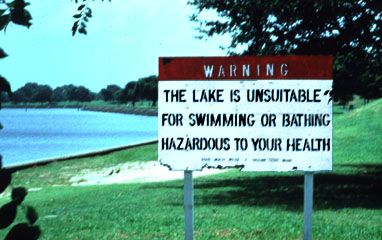 |
| Then (1972) |
 |
| Now |
 |
| Now |

As we successfully fumbled onto the landing we turned and peered up into the rectangular tube ascending to the dim light trickling downward from the second floor entry door propped open against the interior wall. In between that door and the motley rescuers were 40 or more faces, some smiling, some fearful, but all anxious. To this day, my recalled first impression was of images of elderly, desperate prisoners peering from the confines of trains during WWII not knowing if they were being rescued or being left to their own devices to escape an impossible plight.

Of course, that impression is grossly exaggerated, but in the dark, humid confines of the stairway filled with forlorn and beleaguered citizens stacked sardine-style shoulder to shoulder between cold concrete walls, pushing forward, both physically and mentally towards potential freedom, that initial impression remains in my brain's RAM.

To Be Continued


